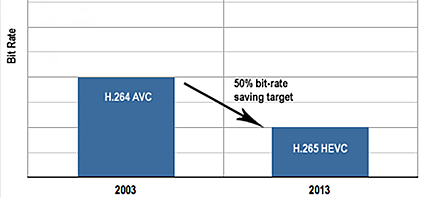

What is H.264?
H264 (aka MPEG-4 AVC) is currently a mainstream video compression format. It is widely used in Blu-ray discs, internet sources like videos in YouTube and iTunes Store, web software, and also HDTV broadcasts over terrestrial, cable and satellite. Learn more about H.264 at wikipedia
What is H.265?
H.265 (also known as HEVC, short for High Efficiency Video Coding) is a video compression standard whose predecessor is H.264/MPEG-4 AVC. H.265 HEVC ensures to deliver video quality identical to H.264 AVC at only half the bit rate. Learn more about H.265 at wikipedia

In general, H.265 has several big advantages over H.264, including better compression, delicate image and bandwidth saving. For more detailed differences, please read H.265 vs H.264 comparison table.
|
|
H.265/HEVC | H.264/AVC |
| Names | MPEG-H, HEVC, Part 2 | MPEG 4 Part 10, AVC |
| Progression | Successor to H.264/AVC | Successor to MPEG-2 Part |
| Key improvement | * 40 - 50% bit rate reduction compared with H.264 at the same visual quality | * 40-50% bit rate reduction compared with MPEG-2 Part |
| * It is likely to implement Ultra HD, 2K, 4K for Broadcast and Online (OTT) | * Available to deliver HD sources for Broadcast and Online | |
| Support up to 8K | Yes | No. Support up to 4K. |
| Support up to 300 fps | Yes | No. support up to 59.94 fps only. |